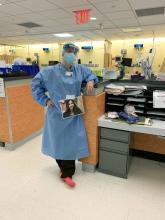News
Can ‘big’ be healthy? Yes – and no
- Author:
- Arghavan Salles, MD, PhD
Publish date: January 27, 2021
We can’t tell very much about a person’s health from their outward appearance, and we should probably stop trying to make such inferences, says...
Opinion

Volunteering during the pandemic: What doctors need to know
- Author:
- Arghavan Salles, MD, PhD
Publish date: May 8, 2020
Just as others helped me achieve my goal of volunteering, I hope I can guide those who would like to do similar work by sharing details about my...
